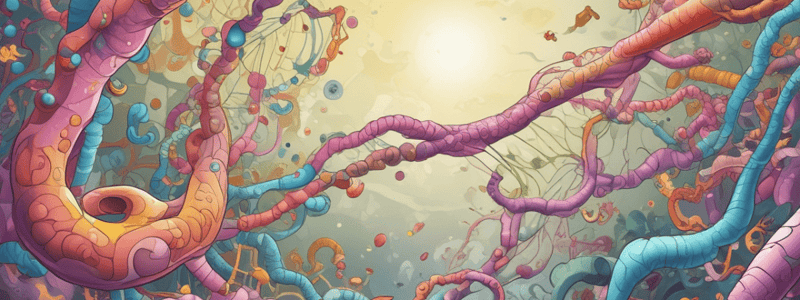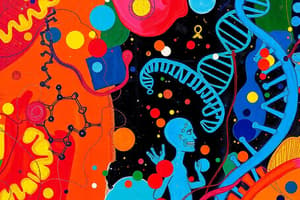Podcast
Questions and Answers
What is the primary mechanism by which RNA polymerase reduces error rates during transcription?
What is the primary mechanism by which RNA polymerase reduces error rates during transcription?
- Unwinding RNA structures to make them accessible to degradation
- Recruiting RNA-binding proteins to proofread the RNA sequence
- Cleaving RNA internally to initiate degradation
- Backtracking and removing incorrect nucleotides from the growing RNA chain (correct)
Which of the following mechanisms is responsible for degrading aberrant RNA molecules in a 3' to 5' direction?
Which of the following mechanisms is responsible for degrading aberrant RNA molecules in a 3' to 5' direction?
- RNA helicases
- RNA exosomes (correct)
- Endoribonucleases
- Nuclear RNA surveillance complex
What is the primary function of the nuclear RNA surveillance complex (NRSC)?
What is the primary function of the nuclear RNA surveillance complex (NRSC)?
- To correct mistakes during transcription
- To initiate RNA degradation in a 3' to 5' direction
- To monitor RNA processing and degradation (correct)
- To unwind RNA structures for degradation
What type of RNA editing involves the use of guide RNA molecules to specify editing sites?
What type of RNA editing involves the use of guide RNA molecules to specify editing sites?
What is the primary function of mismatch recognition proteins in mismatch repair?
What is the primary function of mismatch recognition proteins in mismatch repair?
Which of the following mechanisms is responsible for correcting errors during transcription, but does not involve RNA polymerase?
Which of the following mechanisms is responsible for correcting errors during transcription, but does not involve RNA polymerase?
What is the basis of the mechanism by which RNA polymerase discriminates between correct and incorrect nucleotides?
What is the basis of the mechanism by which RNA polymerase discriminates between correct and incorrect nucleotides?
Which of the following is a function of certain amino acids in the RNA polymerase active center?
Which of the following is a function of certain amino acids in the RNA polymerase active center?
What is the role of the RNA polymerase active center in ensuring correct nucleotide incorporation?
What is the role of the RNA polymerase active center in ensuring correct nucleotide incorporation?
How do certain amino acids in the RNA polymerase active center enhance selectivity between correct and incorrect nucleotides?
How do certain amino acids in the RNA polymerase active center enhance selectivity between correct and incorrect nucleotides?
What is similar between the mechanism of RNA polymerase and the mechanism of tRNA anticodon binding to mRNA codon?
What is similar between the mechanism of RNA polymerase and the mechanism of tRNA anticodon binding to mRNA codon?
What is the outcome of incorrect nucleotide incorporation during transcription?
What is the outcome of incorrect nucleotide incorporation during transcription?
What is the role of the factor of termination (RF1) in the recognition of a codon?
What is the role of the factor of termination (RF1) in the recognition of a codon?
What happens when a nucleotide is introduced incorrectly during elongation?
What happens when a nucleotide is introduced incorrectly during elongation?
Why is the recognition of a codon by RF1 less precise?
Why is the recognition of a codon by RF1 less precise?
What is the role of TFIIS in the correction of errors during transcription?
What is the role of TFIIS in the correction of errors during transcription?
What happens to the RNA when it is backtracked during transcription?
What happens to the RNA when it is backtracked during transcription?
What is the purpose of the proofreading mechanism in E. coli RNA polymerase?
What is the purpose of the proofreading mechanism in E. coli RNA polymerase?
What is the role of transcription factors GreA and GreB during transcription?
What is the role of transcription factors GreA and GreB during transcription?
What is the purpose of the backtracking mechanism during transcription?
What is the purpose of the backtracking mechanism during transcription?
What is the consequence of introducing a nucleotide incorrectly during transcription?
What is the consequence of introducing a nucleotide incorrectly during transcription?
What is the significance of the error rate in translation compared to transcription and replication?
What is the significance of the error rate in translation compared to transcription and replication?
During which stage of translation can errors occur due to incorrect recognition of codon by the anticodon?
During which stage of translation can errors occur due to incorrect recognition of codon by the anticodon?
What is the role of AaRS in the recognition of amino acids and tRNAs?
What is the role of AaRS in the recognition of amino acids and tRNAs?
What is the mechanism by which AaRS discriminates between different amino acids and tRNAs?
What is the mechanism by which AaRS discriminates between different amino acids and tRNAs?
What is the rate of error in the recognition of amino acids and tRNAs by AaRS?
What is the rate of error in the recognition of amino acids and tRNAs by AaRS?
What is the role of the ribosome in the recognition of codon by the anticodon?
What is the role of the ribosome in the recognition of codon by the anticodon?
What is the significance of the 16S RNA in the recognition of codon by the anticodon?
What is the significance of the 16S RNA in the recognition of codon by the anticodon?
What is the primary purpose of the initial tRNA recognition step by aminoacyl-tRNA synthetases?
What is the primary purpose of the initial tRNA recognition step by aminoacyl-tRNA synthetases?
What is the role of AlkB and its homologues in the repair of nucleic acids?
What is the role of AlkB and its homologues in the repair of nucleic acids?
What is the significance of the slow reaction rate in the recognition process?
What is the significance of the slow reaction rate in the recognition process?
What is the role of the additional active site in aminoacyl-tRNA synthetases?
What is the role of the additional active site in aminoacyl-tRNA synthetases?
What is the difference between the AaRS found in the cytoplasm and those found in the mitochondria?
What is the difference between the AaRS found in the cytoplasm and those found in the mitochondria?
What is the significance of the complex formation of up to 11 different AaRS in the cytoplasm?
What is the significance of the complex formation of up to 11 different AaRS in the cytoplasm?
How do aminoacyl-tRNA synthetases discriminate between similar amino acids?
How do aminoacyl-tRNA synthetases discriminate between similar amino acids?
What happens when an incorrect amino acid enters the active site of an aminoacyl-tRNA synthetase?
What happens when an incorrect amino acid enters the active site of an aminoacyl-tRNA synthetase?
What is the purpose of the error-correction mechanism in aminoacyl-tRNA synthetases?
What is the purpose of the error-correction mechanism in aminoacyl-tRNA synthetases?
What is the consequence of a tRNA failing to bind to the synthetase?
What is the consequence of a tRNA failing to bind to the synthetase?
What is the significance of the two-step recognition process in aminoacyl-tRNA synthetases?
What is the significance of the two-step recognition process in aminoacyl-tRNA synthetases?
What is the primary function of the additional active site in the Ile-tRNA synthetase?
What is the primary function of the additional active site in the Ile-tRNA synthetase?
Why is the error rate for aminoacyl-tRNA synthetases relatively low?
Why is the error rate for aminoacyl-tRNA synthetases relatively low?
What is the role of the 16S rRNA in the translation process?
What is the role of the 16S rRNA in the translation process?
What is the consequence of incorrect amino acid loading during the formation of aminoacyl-tRNAs?
What is the consequence of incorrect amino acid loading during the formation of aminoacyl-tRNAs?
What is the purpose of the cellular mechanism of protein re-folding catalyzed by molecular chaperones?
What is the purpose of the cellular mechanism of protein re-folding catalyzed by molecular chaperones?
What happens to proteins that cannot be re-folded due to severe sequence errors or energy pitfalls?
What happens to proteins that cannot be re-folded due to severe sequence errors or energy pitfalls?
What is the result of errors in codon-anticodon pairing during the elongation stage of translation?
What is the result of errors in codon-anticodon pairing during the elongation stage of translation?
What is the primary function of the two independent stages of control during protein synthesis?
What is the primary function of the two independent stages of control during protein synthesis?
What is the approximate frequency of error when discriminating between Ile and Val in the process of amino acid activation?
What is the approximate frequency of error when discriminating between Ile and Val in the process of amino acid activation?
Why does the process of discrimination between Val and Thr in the AaRS of Val involve hidrofobicity?
Why does the process of discrimination between Val and Thr in the AaRS of Val involve hidrofobicity?
What is the function of EF-Tu in the process of translation?
What is the function of EF-Tu in the process of translation?
What is the approximate error rate of the process of translation without EF-Tu?
What is the approximate error rate of the process of translation without EF-Tu?
Why does the process of kinectic discrimination involving EF-Tu reduce the error rate of translation?
Why does the process of kinectic discrimination involving EF-Tu reduce the error rate of translation?
How many ATP molecules are consumed per error corrected in the process of amino acid activation?
How many ATP molecules are consumed per error corrected in the process of amino acid activation?
What is the function of the center of correction in the process of amino acid activation?
What is the function of the center of correction in the process of amino acid activation?
What is the distance between the two active centers of the AaRS?
What is the distance between the two active centers of the AaRS?
Why does the process of correction in the center of correction slow down the global process of amino acid activation?
Why does the process of correction in the center of correction slow down the global process of amino acid activation?
What is the approximate error rate of the process of translation with EF-Tu?
What is the approximate error rate of the process of translation with EF-Tu?
Flashcards are hidden until you start studying
Study Notes
RNA Polymerase Error Checking
Proofreading
- Occurs during transcription, allowing RNA polymerase to correct errors immediately
- RNA polymerase can backtrack and remove incorrect nucleotides from the growing RNA chain
- Error rates reduced by 10-100 fold due to proofreading
RNA Degradation
- Degradation of aberrant or faulty RNA molecules
- Mechanisms include:
- RNA exosomes: complexes that degrade RNA in a 3' to 5' direction
- RNA helicases: unwind RNA structures, making them accessible to degradation
- Endoribonucleases: cleave RNA internally, leading to degradation
RNA Quality Control
- Surveillance mechanisms to detect and eliminate aberrant RNA molecules
- Includes:
- Nuclear RNA surveillance complex (NRSC): monitors RNA processing and degradation
- Cytoplasmic RNA quality control: involves RNA-binding proteins and degradation machinery
Editing
- Post-transcriptional modification of RNA to correct errors or change sequence
- Types of editing:
- Insertion/deletion editing: adds or removes nucleotides from the RNA sequence
- Substitution editing: replaces incorrect nucleotides with correct ones
- Guided editing: uses guide RNA molecules to specify editing sites
Mismatch Repair
- Corrects mismatches in RNA-DNA hybrids, resulting from errors during transcription
- Involves:
- Mismatch recognition proteins: identify and bind to mismatched bases
- Helicases: unwind the RNA-DNA hybrid, allowing repair
- Repair enzymes: correct the mismatch, restoring the correct sequence
Studying That Suits You
Use AI to generate personalized quizzes and flashcards to suit your learning preferences.




